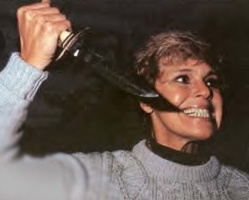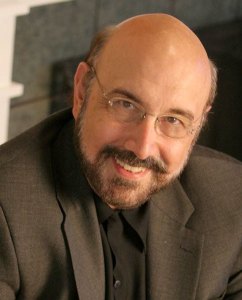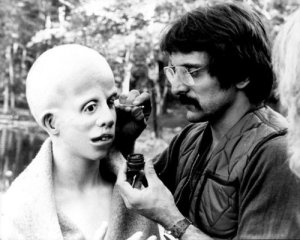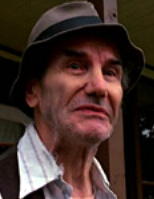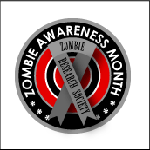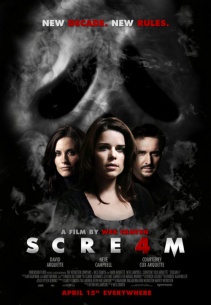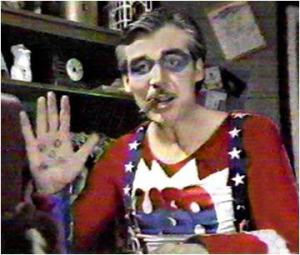Happy Halloween! What? It isn’t Halloween? I get these holidays mixed-up: even though Friday the 13th doesn’t have quite the same commercial appeal (or potential for alcohol sales) as Halloween, it’s the next best thing for horror fans around the world, as it typically represents the other day when we can convince non-horror fans to sit down and watch horror movies with us, one after the other. We might arrange the film festivals to reflect the best of the best, or the worst of the worst, or remakes, or slashers, or whatever– but we’re just happy to share our love for the genre with others, no matter what sub-genre we’re using to warp their fragile little minds.
But on Friday the 13th, it’s good to talk about…Friday the 13th.
Not the date, but the durable movie franchise that’s now in its fourth decade of convincing moviegoers to refrain from premarital sex, and/or smoking pot, while camping out. And to beware of hockey goalies encountered anywhere outside a sanctioned NHL event.
The basic outline of how Friday the 13th came to be is fairly well known to the genre faithful: producer Sean Cunningham, who had worked with Wes Craven on the classic (and controversial) film Last House on the Left in 1972, wanted to return to the horror genre in 1980, and after coming up with the Friday the 13th title, he placed an ad in Variety touting Friday as “the most terrifying film ever made”– simply to determine if the name had already been reserved by another production company, and before the script (such as it was at that point) had even been completed.
Although Cunningham would produce and direct the all-important debut entry in the Friday the 13th series, it was writer Victor Miller, an award-winning soap-opera writer, who conceived the twisted saga of Camp Crystal Lake and Pamela Voorhees and her doomed son, Jason. With Cunningham’s input, the script’s requisite sex and violence levels were quickly punched up and the film went into production.
Friday the 13th was released in 1980, seemingly just another blood-soaked entry in the crowded market of indie horror movies, many of them low- and no-budget Halloween imitators: among the horror shows released that year were Deodato’s Cannibal Holocaust, Fulci’s City of the Living Dead, Carpenter’s The Fog, He Knows You’re Alone, Terror Train and Prom Night (both with Halloween star Jamie Lee Curtis), William Lustig’s Maniac, and Night of the Demon (not to be confused with Kevin Tenney’s classic haunted-house flick, Night of the Demons, from 1988).
Why, then, did Friday go on to become a hit, earning an estimated $60 million worldwide from a budget of just $500,000?
1. Taking “this piece of crap” seriously
The soap-opera roots of the movie are readily apparent in the character of Pamela Voorhees, from her anguished monologue near the end of the film to the over-the-top manner in which Mrs. V. takes revenge on her (and her son’s) numerous alleged tormentors. In the hands of any other actress, the part could have been too campy, too serious, too whatever— but actress Betsy Palmer, who took the role because she needed money to buy a new car, took the job seriously, and kept her work in Friday just grounded enough to make Pamela Voorhees plausible. Not somebody we’d like, necessarily, but someone we could, at the very least, understand. The movie was far more violent than she was told it would be, leading Palmer to brand the finished film a “piece of crap,” but in more recent years, as the Voorhees cult grew and the Friday film franchise raked in the GNP of a small European monarchy, Palmer has been more forgiving, attending horror-film conventions and participating in documentaries about horror films and the Friday franchise in particular. While early critics were hard on the first Friday film, and Palmer’s performance in particular, both have aged well, and her work in making Mrs. Voorhees more than the era’s poorly-defined horror heavy, has a lot to do with that. Like Cushing and Lee in their best work for Hammer Films years earlier, Betsy Palmer took the work seriously even when it was hard to take the script seriously.
2. The classic theme
Harry Manfredini had been writing film music since 1976, and worked on nearly a dozen motion pictures before Friday the 13th came along. His work was solid, workmanlike, and not especially memorable, appearing in films like Through the Looking Glass and Manny’s Orphans. When he was commissioned to write music for Friday the 13th, however, seizing on the weird pronunciation and heavy breathing of Betsy Palmer in the final scenes of the movie, Manfredini constructed one of the great horror-character themes. Although the signature theme of the Friday the 13th films is associated with the hockey-masked psycho Jason Voorhees, in fairness it should be regarded as Pamela Voorhees’ theme, first and foremost. Without her– or at least without Betsy Palmer’s iteration of the character– Manfredini might have written something entirely different. Manfredini has since scored more than 80 TV movies and theatrical releases, including other entries in the Friday the 13th series, Wishmaster, and House (the William Katt horror-comedy, not the Fox medical drama), but he will always be associated with what is probably the second most iconic horror theme of all time.
3. Bacon makes everything better
Kevin Bacon’s fifth film was Friday the 13th. He played one of the doomed camp counselors, Jack, with one of the more inventive deaths in the franchise’s storied history, an arrow through the throat (delivered without benefit of a crossbow or anything fancy). This wasn’t Bacon’s first performance, and certainly not his best, but it made the original Friday the 13th an integral component in any game of “Six Degrees of Kevin Bacon.”
4. The crazy guy from Pittsburgh
Visual F/X wizard Tom Savini, who had previously worked with George Romero on the films Martin and Dawn of the Dead (and also worked on another classic from 1980, Maniac), handled the blood, guts, and stabbings showcased in Friday the 13th. Savini’s work on the film extended beyond squibs and slash-marks: before going to work on Friday, he had seen Brian De Palma’s film version of the Stephen King novel Carrie, and he was taken by the “jolt” ending in which Carrie’s hand emerges from the grave, vowing revenge and suggesting a sequel. He urged Cunningham and Miller to add just such an ending to Friday, to give audiences one last big scare at the very end of the movie: juxtaposed with Harry Manfredini’s serene closing music and the placid visual of the lake, the shocking emergence of Jason Voorhees (portrayed by Ari Lehman) scared the hell out of audiences in 1980, and continues to do so today. If Savini’s contribution had been limited to making that one important suggestion, he would still be a big part of the movie’s success and the growth of the franchise.
After the success of the first Friday the 13th, sequels were assured, by other writers and other directors, a succession of actors and stunt performers lining up to play Jason Voorhees, his mother, and the by-now-endless parade of horny, stoned teenagers doomed to die by Jason’s hand in and around Camp Crystal Lake. (And in New York. And in outer space. And in Springwood. But I digress.) But of all the films in the series– and of all the horror films mass produced in the 1980s– it is Friday the 13th that holds up the best, and is the easiest to watch. Thanks to Cunningham, Miller, Savini and all the rest, for collaborating to make one of the great slashers and one of the great franchises in American horror history.
And remember: if a guy named Crazy Ralph warns you about a death curse…you should probably listen to him.
